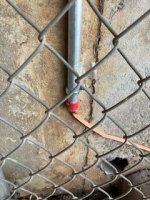I have been given the responsibility of looking at the work of a contractor on behalf of my organization. We had a contractor install a 480/277V service to part of a large building. I noticed that the electrical contractor ran the grounding electrode conductor (GEC) from the service inside of the commercial building through EMT and to the ground rods. I also noticed that the EMT is bonded at the service end but not at the ground rod end. I called out a code violation and sited 250.64 (E) to my boss who passed it on to the project manager in our organization that handles dealing with the contractor. The comment that came back to me was that it was bonded at one end and that was good enough. I get the impression that the contractor convinced our projects guy that it was good enough. I know that 250.64 (E) is very clear. What I would like to know is what trouble could we see from this code violation. Does anyone have any information on this?
One thing that I am not sure that I fully understand is how the incorrect bonding would effect various needs.
1. Static discharge
I am not an engineer. So, I don't know how static discharge would be effected by faulty bonding. Maybe it could make a great capacitor. Ha!
2. Lightning
I know that lightning is static discharge on a much higher level. I know that Mike Holt had mentioned that there is a frequency to lightning even though it is not AC.
3. Fault current
As far as fault current, I am not sure that is even an important issue. The ground rods make a terrible path for current back to the transformer--as far as I can tell. Does it matter?
As far as loads in the building, There is a large AHU run on 480V 3-phase. There is a transformer to step down to 208/120V for lighting and office space. Also there is IT equipment including desk top PCs. It is likely that we may add more loads in the future.

Thank you for any information that you could provide. It would be helpful to show them what kind of damage that could be caused if in fact it is a problem. I assume that the NEC is written by experienced people who have good reasons.
One thing that I am not sure that I fully understand is how the incorrect bonding would effect various needs.
1. Static discharge
I am not an engineer. So, I don't know how static discharge would be effected by faulty bonding. Maybe it could make a great capacitor. Ha!
2. Lightning
I know that lightning is static discharge on a much higher level. I know that Mike Holt had mentioned that there is a frequency to lightning even though it is not AC.
3. Fault current
As far as fault current, I am not sure that is even an important issue. The ground rods make a terrible path for current back to the transformer--as far as I can tell. Does it matter?
As far as loads in the building, There is a large AHU run on 480V 3-phase. There is a transformer to step down to 208/120V for lighting and office space. Also there is IT equipment including desk top PCs. It is likely that we may add more loads in the future.

Thank you for any information that you could provide. It would be helpful to show them what kind of damage that could be caused if in fact it is a problem. I assume that the NEC is written by experienced people who have good reasons.

